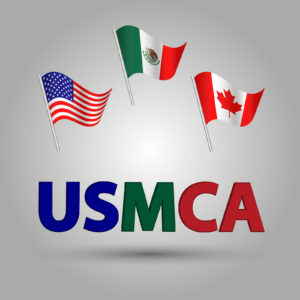Even before the ink on the United States-Mexico-Canada Agreement (USMCA) was dry, the debate around which countries won and which countries lost was in full swing.
U.S. President Donald Trump, President Enrique Pena Nieto of Mexico and Prime Minister Justin Trudeau of Canada have been busy framing the new deal for their constituents, but what has largely been overlooked is the promise that comes from each country reaffirming a shared belief that we are all better when our North American economy is integrated.
Our continent has been a global economic powerhouse for decades and the USMCA — while not perfect for any one country — encourages the kind of collaborative give and take that’s needed to create jobs, foster innovation and improve quality of life for more of our fellow countrymen and women. Nowhere is that spirit of collaboration and connectivity more evident than in the border economies that dot our hemisphere.
North America is home to a handful of rapidly growing border regions that punch above their weight — and overcome occasional tendencies toward protectionism in each of our countries — to build hubs of economic activity that can drive opportunity and prosperity across North America. These border regions have long been sources of human capital and innovation. Under the USMCA, there’s opportunity to accelerate their growth even more for the greater good.
Here are three lessons for policymakers across North America to consider as we strive to recognize the full promise of the USMCA:
- Recognize that these regions are already massive hubs of economic activity that benefit both sides of their borders.
This sentiment is already driving officials in Seattle and Vancouver, Canada, to launch a high-speed rail connecting both cities. The effort will generate more than 150,000 jobs per year and more than $600 billion in business output.
A similar phenomenon is taking place along the southern U.S. border connecting California and Baja California. This border region has grown significantly over the last decade and now represents more than $255 billion in combined gross domestic product. Companies are increasingly locating and growing in this region, and talent from both sides of the border is driving innovation and helping meet much-needed demand for human capital.
This rapid growth is one of the reasons the San Diego-Tijuana border is the busiest land crossing in the Western Hemisphere with more than 125,000 vehicles and 63,000 pedestrians crossing the border every day for work, education and more. A great example of the dynamic of these two border cities is the Cross Border Xpress, the first ever skywalk to connect a facility in the United States directly into a foreign airport terminal (Tijuana).
- Embrace the increasing global significance of these regions.
Border communities certainly hold regional power, but the cross-border collaboration inherent to these regions give them out-size economic influence on the global stage.
Take Baja California. This state on the Mexico-U.S. border is now home to 900 manufacturing companies from around the globe in growing sectors including aerospace, automotive, technology, medical device manufacturing and more. This includes companies from the Europe, Japan, China and, of course, the United States. Industrial activity in Baja California increased 5.6 percent in the past year, well above Mexico’s national average, placing it as the No. 1 border state and seventh nationally in terms of growth. Increasingly so, many of these companies have incorporated higher value-added processes, evolving from mere cost centers to strategic business assets.
- Engage universities to feed long-term economic success.
As is the case in Silicon Valley, Research Triangle in North Carolina, or the biotech hubs of Massachusetts — universities along borders are also nurturing talent and creating the next generation of innovative professionals.
Border regions can serve as innovation clusters when academic institutions are collaborating closely with business leaders. These alliances have helped make the San Diego, Tijuana and Mexicali cross-border economy an example of what’s possible elsewhere in North America.
My institution — CETYS University — is becoming a brain magnet for the entire region, and that makes us as important to the United States and the world as we are to Latin America. Our faculty members and students are at the forefront of entrepreneurship and innovation and many of them travel between the United States and Mexico every day.
Success has come in part through innovative partnerships for strategic human resource development that include local governments, corporate leaders and universities on both sides of the border.
Examples range from medical technology graduate programs developed by our faculty in collaboration with St. Cloud State University and Medtronics, to a joint project with UC San Diego to support the semiconductors industry or other collaborations that develop talent for a growing aerospace sector. These partnerships demonstrate what’s possible through intentional transnational collaboration.
So, let’s stop debating which countries won and which countries lost under USMCA. All our countries are better when we’re integrated and innovating for a brighter North American economy, acknowledging the promise of collaborative effort to drive continued growth.

